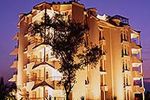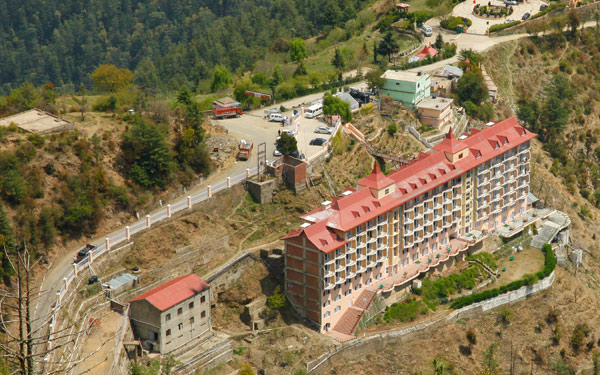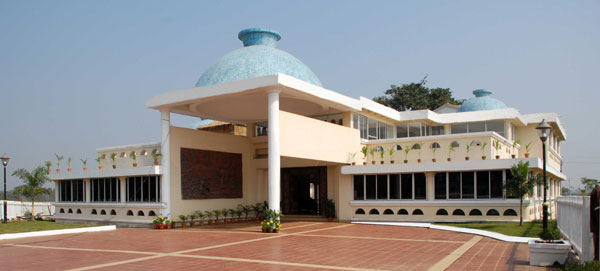Ahmedabad - - Manchester of India OR Boston of India
DISTANCE - 915 KM From Delhi, 394 KM From Porbandar, 216 KM From Rajkot
CONNECTION
By Air : Ahmedabad airport has strong networks of flights running to almost all national and international destinations. It is 10 km north of the city.
By Rail : Ahmedabad is one of the important railway destination and is well connected by trains with Delhi, Mumbai, Vadodra and Udaipur ad other states of India.
By Road : Ahmedabad has a good road network. By road it is linked with towns like Vadodra, Rajkot, Palitana and Jamnagar.
ABOUT AHMEDABAD
Ahmedabad is a beautiful city in the traditional state of Gujarat. It is a centre for a large number of trade and commerce I Gujarat. Up to the mid 19th Century, it was a major textile manufacturing centre and was called the Manchester of India. Ahmedabad is now growing industrially very fast. Ahmedabad is a major educational centre for technical studies like Indian Institute of Management, Physical Research Laboratory, Indian Space Research Organization, National Institute of Design and the Academy of HRD.
Famously associated with the great leader of India, Mahatma Gandhi, this city is a witness to a series of highs and lows in the Indian history. This chronological backdrop of Ahmedabad acts as a principal point of interest among travelers all over the world. The city of Ahmedabad, set along the banks of the River Sabarmati, is acknowledged as a place bearing a rich history and culture. One of the most frequent tourist destinations in India, Ahmedabad allows a tourist to look closely into an exclusive style of architecture, showing marked influences of Hindu and Islamic styles (Indo-Saracenic style of architecture). Often called the 'Manchester of the East', it is today globally famous for its flourishing textile industry.
PLACES OF INTERESTS IN AHMEDABAD
Sabarmati Ashram: 7 km from the centre of town, on the west bank of the Sabarmati River, this was Gandhi's headquarters during the long struggle for Indian independence. This ashram was founded in 1915 and still makes handicrafts, handmade paper and spinning wheels. Gandhi's Spartan living quarters are preserved as a small museum and there is a pictorial record of the major events in his life.
Bhadra Fort & Teen Darwaja: Bhadra Fort was built by the city's founder, Ahmed Shah, in 1411 and is named after the goddess Bhadra, an manifestation of Kali. It now houses government offices and is of no particular interest. There is a post office in the former Palace of Azam Khan, within the fort. To the east of the fort stands the triple gateway, or Teen Darwaja, from which sultans used to watch processions from the palace to the jama Masjid.
Jama Masjid:The Jama Masjid, built in 1423 by Ahmed Shah, is beside Mahatma Gandhi Rd, just to the east of the Teen Darwaja. Although 260 columns support the roof and its 15 cupolas, the two 'shaking' minarets lost half their height in the great earthquake of 1819, and another tremor in l957 completed the demolition Much of this early Ahmedabad mosque was built using items salvaged from the demolished Hindu and jain temples. It is said that a large black slab by the main arch is actually the base of a Jain idol, buried upside down for the Muslim faithful to tread on.
Tombs of Ahmed Shah his Queens:The tomb of Ahmed Shah, with its perforated stone windows, stands just outside the east gate of the Jama Masjid. His son and grandson, who did not long survive him, also have their cenotaphs in this tomb. Women are not allowed into the central chamber. Across the street on a raised platform is the tomb of his queens - it's now really a market and in very poor shape compared to Ahmed Shah's tomb.
Shaking Minarets: Just south of the railway station, outside the Sarangpur Gate, the Sidi Bashir Mosque is famed for its shaking minarets, or jhulta minars. When one minaret is shaken, the other rocks in sympathy. This is said to be a protection against earthquake damage. It's a fairly fanciful proposition, and one which you'll be unable to verify, unless of course you happen to be on the spot during an earthquake.
Dada Hari Wav: Stepwells (wavs or baolis) are strange constructions, unique to northern India, and Dada Hari Wav is one of the best. Built in 1501 by a woman of Sultan Begara's harem, it has a series of steps leading down to lower and lower platforms terminating at a small, octagonal well. The depths of the well are cool, even on the hottest day, and it must once have been quite beautiful. Today, it is completely neglected and often bone dry, but it's a fascinatingly eerie place with galleries above the well and a small portico at ground level. The best time to visit and photograph the well is between 10 and 11 am; at other times the sun doesn't penetrate to the various levels. Entry is free. Behind the well is the equally neglected mosque and rauza (tomb) of Dada Hari. The mosque has a tree motif like the one on the windows of Sidi Saiyad's Mosque.
RELIGIOUS PLACES IN AHMEDABAD
Akshardham Temple : A specimen of fine craftsmanship, the Akshardham temple in Ahmedabad is one of the largest and most prominent temples in the entire state of Gujarat. Located in Gandhinagar city, the famous Ahmedabad Akshardham temple is a place, which consists of a number of things under one roof like art, education, architecture, exhibitions and research. It is truly an architectural masterpiece.
Hathee Singh Temple : Constructed in the year 1850 AD, Hathee Singh temple is a very famous Jain temple. It has been named after its founder Seth Hathee Singh, a prosperous Jain merchant. Hathee Singh Jain temple of Ahmedabad was built in the dedication of the 15th Jain Trithanakara named Dharmnath. The temple is known for its fabulous architectural styling and designing that consists of intricate carvings.
Ahmed Shah Mosque : Sultan Ahmed Shah mosque in Ahmedabad is a religious place for Muslims that is well known for its architectural designing. It was constructed in the year 1414 A.D. by Sultan Ahmed Shah, the founder of Ahmedabad city. Thus, the mosque has been named after its founder. Lying on the left side of the famous Bhadra Fort, the mosque is very appealing to look at. It is one of the oldest mosques of Ahmedabad.
Rani Rupmati Mosque : Located on the Northern side of the Ahmedabad city, Rani Rupmati mosque was established by Sultan Mehmud Beghara. Named after Rani Rupmati, the wife of Sultan, the mosque was constructed during 1430-1440 AD. Some of the features that best describe the Rani Roopmati mosque of Ahmedabad, Gujarat are impressive domes, carved galleries and tall minarets.
Sidi Sayed Mosque : Located near Lal Darwaza in Ahmedabad, the mosque of Sidi Sayed is one of the most prominent mosques in the Ahmedabad city. Constructed in the year 1573, the mosque was established by Sidi Sayed, a slave of Sultan Ahmed Shah. Sidi Sayed mosque in Ahmedabad, India consists of ten semi circular windows, the appeal of which is accentuated by the splendid mesh covering them, which is more popularly known as ‘Jali’.
Swaminarayan Temple : The first and foremost Swaminarayan temple was built at Kalupur in Ahmedabad. Being the most prominent temple, it is always thronged by people. People come from different parts of the country and congregate here in this temple to seek the blessings of the deity. Dedicated to Lord Swaminarayan, the temple boasts of its exquisite wooden carvings.
WHEN TO GO AHMEDABAD
Best time to visit Ahmedabad is in the months of winter when temperature remains favorable as temperature rises almost to 50 C in the months of summer.
WEATHER FORECAST
Ahmedabad is basically a hot place that enjoys three main seasons, namely summers (March to June), winters (November-February) and monsoon (July-September). During the summer season, the temperature on a hot sunny day ranges between 44 and 47 degree Celsius. Due to high temperature, it is not preferable to visit the place during summers which last during the months of March and June, the weather is very hot and dry. The average temperature ranges between the 23°C to 43°C. The highest recorded temperature is 47°C.
During the winter months, i.e. from November to February, the climate is quite pleasant. During this time, the temperature ranges from 15°C to 35°C and the city experiences extremely dry climatic conditions. One can feel a slight chill during the month of January, mainly because of the cold northerly winds flowing in the region.
EVENTS AND FESTIVALS IN AHMEDABAD
Ahmedabad offers visitor a rich array of events and festivals throughout the year that highlight its unique cultural identity and history. We highlight the key events and festivals in Ahmedabad from month to month, providing visitors with a huge choice of possible choice to play that once in a lifetime holiday around. Each one brings to life why Ahmedabad is so representative of people from India. With its mix of Hindu and Islamic holidays as well as traditional Gujarati and Indian festivals, Ahmedabad is a destination that features regular special events, some of which are also unique to the city, such as the visually impressive Kite Festival in which the climax is a hectic kite fight. One of the most intriguing Gujarati festivals is Navratri, a nine-day event that sees hours of tireless dancing by local inhabitants when the women come to the fore.
Kite Festival: Held in the middle of the month, the Ahmedabad Kite Festival, also known as Uttarayan, is one of the highlights of the holiday calendar attracting kite fliers from across the world and causing the skies over the city to become filled with colour.
Saptak Music Festival: Held every year at the beginning of the January, this 11-day music festival has become an institution in the city since it was first held in 1980. Musicians of all ages are encouraged to display their talent, whether performing individually or in a group. Performers are mostly from Gujarat, but many others from other areas of India participate too.
Holi: a festival in celebration of the beginning of spring, Holi sees the throwing of coloured powder and water which is thought to reduce the threat of cold and fever at a time when the body is perceived to be vulnerable due to the change in season. Traditionally, the coloured powders were made up of medicinal herbs.
Rath Yatra: prompting the largest procession in the state, Rath Yatra in early July sees the pulling of chariots and large swarms of people in the streets in commemoration of the departure of Krishna. Decorated elephants and music bands are the highlight of processions during this celebration.
Tarnetar Fair: exclusive to Ahmedabad, this festival takes place at the end of August or beginning of September at the Trinteshwar temple of lord Shiva. During the festival, locals believe that any woman who stops to converse with a man is deemed to spend the rest of her life with him.
Ramadan: the traditional month of abstinence and fasting is a significant part of the religious calendar for Ahmedabad’s Muslim population which equates to about one in 10 people here. Ramadan means regular visits to the mosque and fasting during the day, but little in the way of tangible celebration that is noticeable to outside visitors.
Navratri: lasting nine days, Navratri is a festival celebrated across Gujarat that sees young people dress in their finest traditional clothes ready to dance the garbha every night of the holiday. Women tend to dominate proceedings, clapping their hands and singing around a special lamp.
Eid: marking the end of the holiday month of Ramadan, Eid is a popular Islamic holiday in Ahmedabad that sees Muslims dress in their finest clothes before prayers at any one of the mosques in the city. Traditionally, families greet each other and enjoy a large meal which includes toasted vermicelli noodles.
Diwali: this major Hindu festival usually takes place in late October/early November. Also known as the ‘festival of light’, Diwali lasts five days and is held in celebration of the victory of good over evil, an event marked with abundant lights and candles throughout Ahmedabad.
Nazariya Films for Peace Festival: this pioneering annual film festival focuses on human rights and alternative cinema, encouraging entrants to submit short films and documentaries for consideration which are then shown in the city.
Christmas: less than one percent of Ahmedabad’s population is Christian but that still translates to nearly 40,000 people who eagerly celebrate the most important holiday of the year according to their faith. Expect carol services, singing and the exchange of gifts on Christmas Day.
FOOD AND RESTURANTS IN AHMEDABAD
Ahmedabad caters to every taste from home cooked Gujarati thalis to delicate epicure meals. The predominantly vegetarian Gujarati cuisine with its dal, bath, roti, dhokla, kadhi, and theplas is irresistable. Add to this the delights of Srikhand and Doodhpak and the rich flavours of Undhyoo. For an authentic Gujarati experience order a Thali in any Gujarati restaurant in Ahmedabad. Choose between Spicy North Indian flavours or delicious South Indian food. Explore and eat at the Law garden and the C. G. Road municipal market eateries to experience the real Amdavad.
Bavarchi, Café Upper Crust, Choice, China town, Chills Thrills & Frills, Collegian, Colours of Spice, Dominoes Pizzas, Havmor, Khyber, Mirch masala, Paramount, Patang, Pizza Hut, Ranch, Sankalp Sheeba, Tomatoes, Woodlands. |
|








